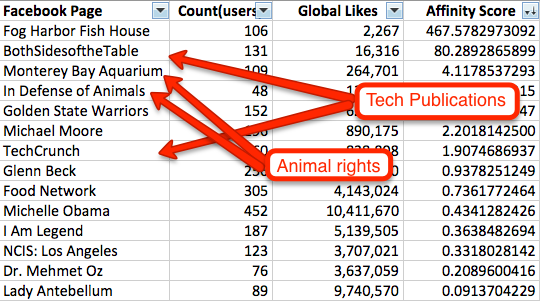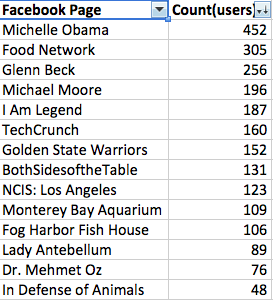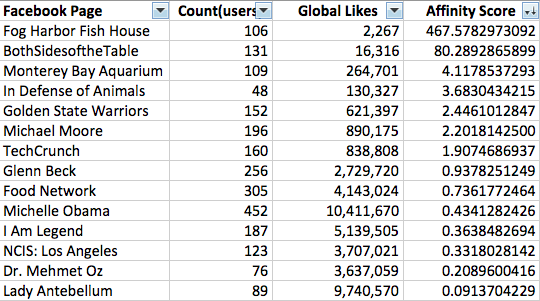A clever way to buy Facebook ads based on what your users like (Guest post)
My friend Gagan Biyani wrote up a great piece how to analyze what your Facebook audience is interested in, and using that to buy ads. He’s generously shared it, below. Gagan is CEO and co-founder at Sprig, and before that was at Lyft and started up Udemy. You can follow him on Twitter at @gaganbiyani and he has a new Medium account here. -Andrew
Gagan Biyani, Sprig:
Building Target Groups for Facebook Ads
Facebook advertising is tricky and there are multiple facets to it. By far the most important value of Facebook is being able to target based on demographic information. In this post, I’ll show you exactly how to use the “affinity ratio” to figure out what Facebook likes to target and dramatically increase the performance of your Facebook advertising.
As mentioned above, you have to have Facebook Connect on your app and you must grab the likes of your users. A sample of your users is OK so even if Facebook Connect is merely one option amongst many, that’s fine.
(Credit: This method was created by my co-founder at Udemy, Eren Bali. We tested dozens of other forms of targeting and nothing came close. I’m sure there are many other companies that have come up with this on their own.)
Note: this only works if you have Facebook like data from your user base
Step 1: Figure out what Facebook pages your users like
Here’s the trick: Download a CSV of all of the unique facebook pages your users like and the COUNT() of the number of users who like each page. Example:
You’ll notice these numbers don’t make a whole lot of sense. That’s because I made them all up!
Notice a few things. First, this list is sorted by greatest # of likes. That list is already a bit useful — and probably something you’ve looked at before. The problem is it doesn’t make this data useful enough.Everyone and their mom’s likes Michelle Obama, so you can’t target your advertising that way. From here, you have to figure out which one of these pages is actually useful to you.
Second, if you have any reasonable-sized user base, you’ll probably have 1000’s of results on the left column. That’s fine but we’ll use a small list for this example. You may have to have some sort of COUNT() limit to make this easier (aka only pages with over 1,000 likes make the cut).
Step 2: Add in the “Global Likes” of those Facebook Pages
Now you need to figure out how many globlal likes each of the pages on your list has. Use the Facebook API or do it manually if you don’t have access to dev resources.
In our B.S. data set above, I went ahead and did it manually. Here’s the data:
In case you’re wondering, I came up with this list by checking Facebook’s page recommendations. They were right on some things (who doesn’t like a little Dr. Oz in the mornings?) and wrong on others (phh, I don’t care about animals).It is probably starting to make sense now. Its not just about the total count of your users who like a given page, its actually about the relativecount.
Step 3: Create a ratio of [Count(users)]/[Global Likes]
From here, your goal is to create an “affinity score” (name created by Dinesh Thiru, who runs marketing at Udemy)
To make these numbers easier to read, I multipled the affinity score by 10,000. Depending on the number of users you have in Column Count(users), you may multiply by a smaller factor of 10.
Now, you have a relative score that allows you to compare different pages. I sorted this list by affinity score. Its interesting to see pages like “Michelle Obama” and “Food Network” to go from the top to the near-bottom of our list! Of course this is make-believe data, but when you have real data you’ll see similar results.
Step 4: Group your high affinity pages
Once you have a list of affinity scores, you need to group them into categories. This is important because otherwise, you wouldn’t have good Facebook targeting groups. Targeting users who like BothSidesoftheTable and the Golden State Warriors will make it hard to write ad copy and create cohesive campaigns.
 Natural groups will form when you start looking at your data.Two things matter when you are in the final stages of this:
Natural groups will form when you start looking at your data.Two things matter when you are in the final stages of this:
- Sample size. The larger the size of your group, the more people you can target with your ads. You don’t want too large a size, though, because then you are paying crazy CPM’s and competing with a larger breadth of advertisers.
- Grouping. This is based entirely on your judgement. The natural groups are always ones where you think there’s a lot of overlap amongst those users. Its fairly obvious that people who like TechCrunch and BothSidesoftheTable overlap. In situations like the Monterey Bay Aquarium and In Defense of Animals group, its just a judgement call. Go with your gut.
- Expand your targeting using groups. As you create groups, it will be easy to start finding more users to target. So if you have tech blogs like TechCrunch on your list, you can add other ones such as PandoDaily, BusinessInsider and even CNet. Be careful though: there may be a reason your users don’t already like those pages. At Lyft and Udemy, we would use separate ad campaigns for “related” groups and monitor performance accordingly.
That’s a wrap folks. If you have questions, please feel free to ask and I’ll try to get to them.
P.S. This is why we started the Growth Hackers Conference and why I regularly read blogs like Andrew Chen’s or Sean Ellis’s. If you like this, I’ll also try to blog more to help share this kind of information. Tips like this used to be locked up in people’s heads — so poor entrepreneurs like me could never learn them. Now, you can pay $300 (with coupon code “FBadv”) and save months of time and thousands of dollars by going to conferences and reading blog posts about growth hacking. You might also find your next opportunity, meet a great candidate or connect with an industry insider who mentors you.
PS. Get new updates/analysis on tech and startupsI write a high-quality, weekly newsletter covering what's happening in Silicon Valley, focused on startups, marketing, and mobile.
Views expressed in “content” (including posts, podcasts, videos) linked on this website or posted in social media and other platforms (collectively, “content distribution outlets”) are my own and are not the views of AH Capital Management, L.L.C. (“a16z”) or its respective affiliates. AH Capital Management is an investment adviser registered with the Securities and Exchange Commission. Registration as an investment adviser does not imply any special skill or training. The posts are not directed to any investors or potential investors, and do not constitute an offer to sell -- or a solicitation of an offer to buy -- any securities, and may not be used or relied upon in evaluating the merits of any investment.
The content should not be construed as or relied upon in any manner as investment, legal, tax, or other advice. You should consult your own advisers as to legal, business, tax, and other related matters concerning any investment. Any projections, estimates, forecasts, targets, prospects and/or opinions expressed in these materials are subject to change without notice and may differ or be contrary to opinions expressed by others. Any charts provided here are for informational purposes only, and should not be relied upon when making any investment decision. Certain information contained in here has been obtained from third-party sources. While taken from sources believed to be reliable, I have not independently verified such information and makes no representations about the enduring accuracy of the information or its appropriateness for a given situation. The content speaks only as of the date indicated.
Under no circumstances should any posts or other information provided on this website -- or on associated content distribution outlets -- be construed as an offer soliciting the purchase or sale of any security or interest in any pooled investment vehicle sponsored, discussed, or mentioned by a16z personnel. Nor should it be construed as an offer to provide investment advisory services; an offer to invest in an a16z-managed pooled investment vehicle will be made separately and only by means of the confidential offering documents of the specific pooled investment vehicles -- which should be read in their entirety, and only to those who, among other requirements, meet certain qualifications under federal securities laws. Such investors, defined as accredited investors and qualified purchasers, are generally deemed capable of evaluating the merits and risks of prospective investments and financial matters. There can be no assurances that a16z’s investment objectives will be achieved or investment strategies will be successful. Any investment in a vehicle managed by a16z involves a high degree of risk including the risk that the entire amount invested is lost. Any investments or portfolio companies mentioned, referred to, or described are not representative of all investments in vehicles managed by a16z and there can be no assurance that the investments will be profitable or that other investments made in the future will have similar characteristics or results. A list of investments made by funds managed by a16z is available at https://a16z.com/investments/. Excluded from this list are investments for which the issuer has not provided permission for a16z to disclose publicly as well as unannounced investments in publicly traded digital assets. Past results of Andreessen Horowitz’s investments, pooled investment vehicles, or investment strategies are not necessarily indicative of future results. Please see https://a16z.com/disclosures for additional important information.



